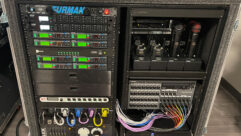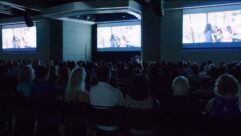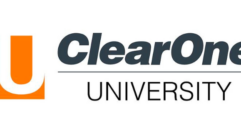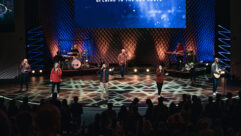
Houses of Worship — August 18, 2005
Aug 18, 2005 4:37 PM
Houses of Worship Top Story
Church AV Systems Idle Due to Training Gaps?
How much costly and capable audio and video gear is sitting unused in America’s churches? How much of that idleness can be blamed on church volunteers just not knowing how to use the systems?
Training of church media users is a perennial issue, and one that appears to have no easy solution despite the proliferating range of educational options available. Moreover, the largest churches with the most sophisticated installations are by no means immune to its effects.
The Hartford Institute for Religion Research (HIRR) is in the process of updating its landmark study of “megachurches,” which it defines as churches with a typical attendance of more than 2,000. One of the things the survey update will explore is the role of volunteers, especially in using video and other media systems to enhance worship.
HIRR has revealed that 72 percent of all megachurches use visual projection equipment—or at least have it installed. In contrast, the institute has recently reported that 34.8 percent of survey respondents say they never use their projectors, and another quarter say these systems are seldom used.
Part of the challenge, of course, is keeping volunteers up-to-date. Among megachurches, HIRR reports an average of nearly 300 volunteers are involved in every aspect of church activity. In any population that large, there’s turnover, because people’s interests change or they move in and out of an area.
How do churches train new people to use systems already installed? How do they update the skills of their experienced volunteers?
The first stop for many is the systems integrator who designed and installed their equipment. Some degree of user training, including follow-ups, is generally included in the installation contract, and a number of prominent integrators make a point of offering both product-specific and more general training to their customers and others.
Audio-Visual Innovations, for example, included worship-related topics in the 2005 edition of AVI University, an annual customer education program that took place in July. The event drew more than 500 people, AVI reports.
“Reducing Stage Levels in Worship Applications,” for example, was a class presented by Tom Knesel of Aviom that provided a number of practical tips and church examples illustrating techniques for monitor mixing and distributed audio systems.
Glenn Collinge, southeast regional sales manager at FSR, gave a talk on “Video Projection in the House of Worship.” Collinge also shared with attendees his views on the most popular technological developments emerging currently in churches, including a shift to 16:9 projection, lens-free projectors, and more use of simple and inexpensive Cat-5/6 cabling in church systems.
Numerous other integrators are also reaching out to the church community. Ford Audio-Video stages seminars at a number of locations and maintains an active church media message board. Users also turn in large numbers to such communities as Churchmedia.net, which offers one-day church media seminars all over the country on a regular schedule.
And, as HOW reported last issue, more and more trade shows, large and small, are either entirely devoted to worship media or incorporating this fast-growing specialty in their larger exhibitions.
It’s all part of an effort to get people trained, keep them trained, and keep that census of idle AV equipment from growing any further.
Installation News
Vassar Chapel Acoustics Fine-tuned by WSDG
Founded in 1861, Vassar College is recognized as one of America’s leading Liberal Arts colleges. Located in the scenic Hudson Valley, 70 miles north of New York City, this lovely campus is particularly proud of its magnificent Norman Revival Chapel. While Vassar does not have any particular religious affiliation, the college is committed to providing an environment that supports religious and spiritual inquiry through the programming of the Office of Religious and Spirtual Life.
Services conducted in the chapel include a weekly Catholic Mass as well as weddings and funerals for members of the Vassar community. In addition, the space is used to facilitate the exploration of other expressions of ritual, faith, and commitment through the Arts and Celebration program. As part of the College’s community outreach, the chapel also hosts events and services through the Dutchess County Interfaith Council for the Poughkeepsie, N.Y., community.
But, for all its wood and stonework, Gothic beauty, and historical significance, the acoustics in the Vassar Chapel were being compromised by an antiquated sound reinforcement system that negatively impacted every event held there.
Charged with finding an acoustic and sound system consultant to correct this significant issue, Susan Stephens, who at that time was the manager of media resources at the college, discovered a world-renowned acoustician literally in her own backyard. Walters-Storyk Design Group is a 30-plus-year-old architectural/acoustic firm based in Highland, N.Y., just 15 minutes from the campus. WSDG has created nearly 2,000 recording studios, home theaters, distance learning centers, broadcast facilities, and sophisticated audio and video production environments. Credentials that run the gamut from Crossroads, a New York Tabernacle with its own state-of-the-art recording studio, to the new Jazz At Lincoln Center complex in Manhattan’s new Time-Warner Building, convinced Stephens, who currently serves as assistant to Vassar’s VP for computing and information services, that her next-door neighbors were the ideal choice for this assignment.
“Uses for the chapel have changed dramatically over the years,” Stephens says. “It’s one of the few venues on campus capable of accommodating a large audience. We had long been aware of the unintelligibility problem, but the issue became a priority when a presentation by actor Tom Hanks could not be heard by people in the balcony. Finding the Walters-Storyk Design Group so close to home was a distinct advantage, not only because of their proximity, but because project principals Dirk Noy and John Storyk matched our enthusiasm for preserving the building’s historical integrity. We were also pleased with their flexibility in working with our long-standing systems installation firm, Connecticut-based HB Communications.”
“The existing sound reinforcement system had been in place over twenty years,” Storyk explains. “The audio quality of the chapel’s old center cluster speaker array was woefully inadequate for both spoken word and musical events. The system they required was accompanied by one additional caveat. In addition to plug-and-play simplicity for non-technical personnel operation, and auto/manual modes for more sophisticated technicians, and [going] beyond the need to cover the entire audience area (the chapel seats 1,100) with crystal-clear sound, whatever new system we recommended needed to be as close to invisible as possible.”

Storyk and Noy conducted a series of tests to measure, analyze, and eventually calibrate the chapel’s acoustics. The results revealed that RT60 reverb time was measured at 2.5 seconds in mid frequencies, far afield from the room’s optimal 1.5-second requirements. It was fixable, yes, but complicated by Vassar’s aesthetic “hear all speakers; see no speakers; make no changes to the chapel architecture” mandate.
Extensive research and planning led the WSDG team to recommend a sophisticated, digitally controlled, electro-acoustical solution capable of covering the entire seating area and balcony. A combination of modern line array and conventional passive speakers were selected. To ensure the integrity of the manual mix mode, a password must be entered into a programmable remote before integrating multiple microphones, an additional analog mixer, and other sources into the system.
The complex speaker install was a formidable undertaking involving careful mounting of the speakers at a height of more than 30ft. The main front left/right loudspeakers, EAW DSA 230/250, installed one above the other, are digitally controllable line arrays. EAW JF80 delay loudspeakers were chosen for the rear seats and the balcony. Discreetly tucked into a vestibule, the equipment rack features a powerful collection of digital technology. The system includes: a CD player, a tape deck, multiple wireless microphone receivers, Crown amplification, BSS Soundweb Digital Signal Processing (DSP), and a BSS Jellyfish Remote Control user interface with LCD screen and password privilege management.
The proof of any successful installation is in its performance. Both Stephens and Professor Rachel Kitzinger, director of academic facilities development, report that the Chapel’s new sound reinforcement system is crisp, clear, virtually invisible, and entirely appropriate for the diverse needs of this 101-year-old centerpiece of a 144-year-old institution.
Perimeter Church Goes All-Innovason
At Perimeter Church, a progressive, 2,300-seat Christian worship center based in greater Atlanta, much emphasis is placed upon the incorporation of fine art in ministry. Most notably apparent in Perimeter’s dynamic musical services, as well as in the ‘Academy of the Arts’ educational programs, this flourishing Southern house of worship spares no
effort in providing its members with superior experiences of sight, sound, and message.
Mike Hedden and Neil Philpott, both of Gainesville, Ga.’s dB Audio & Video, recently assisted Perimeter Church in upgrading its substantial EAW array-fronted audio system with the addition of an Innovason Sy48 digital mixing console for on-stage monitoring purposes. This desk joins another Innovason—a massive Sy80 also purchased from and installed by dB Audio & Video—which is located at Perimeter’s FOH position. According to Hedden, the church’s purchase of the Sy48 was prompted by its extreme appreciation for Innovason build-quality, sound, and ease-of-use.
“The Sy48 replaced an old analog Crest console at monitor position and so did the Sy80 at front-of-house,” recalls Hedden of the console switch. “At Perimeter, when the Crest came out from front-of-house, in addition to the console, the Sy80 replaced a considerable amount of outboard gear—with the results being a substantially cleaner signal path. Before the new console was even mentioned to members, everyone was asking, ‘What did you guys do to the sound? It’s so much better!'”
It wasn’t long until Perimeter had placed another Innovason order with Hedden; this time for the Sy48. “The idea was that with the Sy80 stage box already on stage it made sense to get another Innovason,” Hedden explains. “I have an Sy48 for demo purposes, and they used it for their Easter service. They ordered and installed their own shortly thereafter.”
The Sy80—Perimeter’s introduction to the joys of mixing via Innovason—is
an 80-fader, 80-input/output, 48-mix buss, super-configurable console designed for live sound touring, fixed installation, and broadcast applications. Used as a FOH desk, the Sy80 can be used alone or networked to any other Innovason product, such as the Sy48. A compact version of the Sy80, the Sy48 is specifically designed for live mixing up to
64 channels, and features up to 48 local mic/line inputs, up to 48 outputs, and 32 freely assignable busses. Both the Sy80 and Sy48 use Sensoft, Innovason’s comprehensive console control software that allows the saving of setups for instant recall, snapshot automation with MIDI or manual synchronization, offline programming, and much more.
While Hedden has sold his share of well-respected and popular digital consoles, he claims that if a client’s budget allows, he most often recommends Innovason for its simplicity and quality. “I can tell you without question,” he insists, “that the Innovason is the easiest console to mix on—period. The Sy80 has the most faders available. Of course, you have to have budget in mind along with your list of goals, but for a contemporary church, ease-of-use is always going to be at the top of the list. Some of
these other consoles are ‘gizmoed-out’ with all this cool stuff, but 95 percent of the users in a church situation will never even touch the pages that offer all of that stuff. That’s why they need something powerful, but simple to use.”
Before buying their first Innovason, audio department personnel from Perimeter visited dB Audio & Video and auditioned the Sy80 alongside another console consideration, a Yamaha PM1D. “We had them side by side in our shop, and Perimeter spent two full days going through both consoles,” he recalls. “They picked the Sy80. And while I’m a big fan of Yamaha and their products,
the Sy80 was picked because it’s easier to use by the church’s volunteer mixers.”
The intuitive work surfaces of the Sy80 and Sy48 are unique to the digital console world, says Hedden, who has told many a church to “go digital” for a variety of substantial reasons. “We have been recommending digital consoles for a long time,” Hedden says of dB’s predominant house-of-worship client base where fledgling and volunteer engineers are often utilized. “We have 300-plus digital consoles installed out in the field. And in working with churches as much as we do, we feel that the digital console’s real assistance is that a good operator is essentially one file away. We can dial in the mixes and get them in the ballpark. Unlike an analog console, if the settings drift off—such as someone turning the wrong knob—someone must know what’s wrong and how to correct it.”
In illustrating how well-suited Innovason consoles are for houses of worship, Hedden recalls a recent exchange with a client: “Just this morning, I had a conversation with a church about consoles. One person there was pushing hard for another digital console. But I told them, ‘Guys, you’re using all volunteers! Go with the Innovason. It’s by far the easiest console to use, it sounds amazing, and it gives you the most faders on a page at one time.’ Operationally, the Innovason is the closest thing to an analog console in the digital market. I just love that with the Innovason, users can have varying aptitudes.”
Product News

Adamson T-21 Sub
The Adamson T-21 Sub is a flyable and arrayable bass cabinet designed to provide superior sub-bass extension for Y-Axis true line source systems and can be configured into an arc that will not shadow the main line array.
The T-21 Sub incorporates the newly developed Adamson Symmetrical Drive SD-21 Kevlar driver. The double-spider design employs a balanced spider suspension with spiders at both ends of the 6in. dual voice coil assembly and a powerful neodymium magnet, resulting in extreme stability under high excursions and unmatched output and sensitivity.
The SD-21 boasts advanced cone geometries, exceptional power handing, and no distortion, and it has an extremely high stiffness-to-mass ratio, eliminating cone fatigue and ensuring long-term reliability.
T-21 Sub’s tuned enclosure is internally braced to minimize harmonics and distortion, innovative port geometry limits the occurrence of vortices and therefore has increased efficiency, lower turbulence, and reduced compression at high SPL.
T-21 includes AIR (Adamson Integrated Rigging) system captured flying hardware, with five precision rigging angles. Rear hinge allows for 110 degrees of rotational freedom during array assembly and all heavy-duty linkage pins are attached to prevent lost pins during transport.
High-definition Video Gets Distributed with Gefen’s New 2:8 HDMI Distribution Amplifier
Gefen‘s ex-tend-it 2:8 HDMI distribution amplifier is sure to please professionals who need to output high-definition audio and video sources to multiple displays at the same time. With its bonus features, it packs a lot of performance in the plug-and-play box made for signal distribution.
Two switchable inputs allow you to alternate between two sources. Each source delivers resolutions up to 1080p, plus multichannel digital audio to all eight displays, while supporting HDCP (high-bandwidth digital content protection) devices.
Both HDMI and DVI displays can be used with Gefen’s 2:8 HDMI distribution amplifier; DVI displays require an optional Gefen HDMI to DVI adapter.
The 2:8 HDMI distribution amplifier (MSRP $1299) will be available to order on gefen.com beginning in September 2005, where you’ll find additional Gefen solutions and reseller locations.

Crestron Introduces iLux Integrated Zoned Lighting
Crestron introduces its iLux CLS-C6 Integrated Zoned Lighting System. iLux CLS-C6 controls six lighting zones and six groups of shades, and is perfect for new and retrofit applications such as auditoriums, boardrooms, and classrooms. iLux CLS-C6 replaces the litany of switches and dimmers on the wall, and centralizes the lighting, shade, and screen controls. Clients no longer need to search for the right switch plate or fumble through trial and error to find the right combination of light settings. The iLux CLS-C6 enables user-preset lighting scenes, and offers the added benefit of seamless integration with Crestron’s award-winning AV control solutions.
The iLux CLS-C6 is a cost-effective, wall-mount unit featuring built-in dimmer circuits to control six lighting zones. The six front-panel, three-position rocker buttons control each zone and provide white-LED feedback. Corresponding seven-segment LED bargraphs offer easy visualization of lighting levels in each zone. A front-panel “Master” button and large “Off” and “On” buttons provide additional lighting system control. Up to 15 scenes for lighting and shades may be pre-programmed for simple, intuitive client use. Fade time and ramp rate are programmable, along with various system functions such as scene recall, scene off, and master dim control. Each scene may be assigned to individual buttons at setup.
Beyond the extensive yet simple front panel control, the iLux CLS-C6 accommodates up to 16 Crestron keypads and 16 shade controllers for expanded system control capability. An optional built-in motion detector and up to two external motion detectors are available for occupancy sensing to automatically turn lights on or off, or activate a programmed scene. Additionally, up to seven iLux CLS-C6 units may be daisy-chained for extended device control.
System programming is easy from either the front panel using the mode select and setup buttons, or from a PC via the programming port using the supplied intuitive setup software. All programming buttons, ports, and LEDs are elegantly hidden behind an opaque flip-up panel. A built-in astronomical clock ensures reliable system synchronization and timed functionality. Available in black, white, or almond, the iLux CLS-C6 is a cost-effective, versatile and powerful lighting control solution.
For more information regarding iLux CLS-C6, visit www.crestron.com or call 1 (800) 237-2041.










